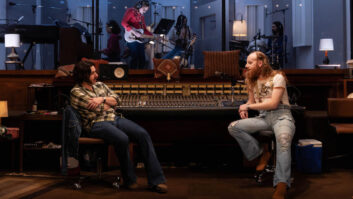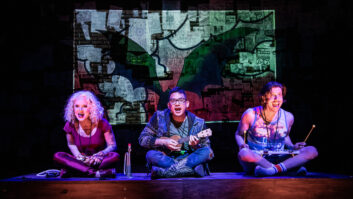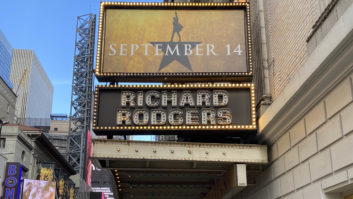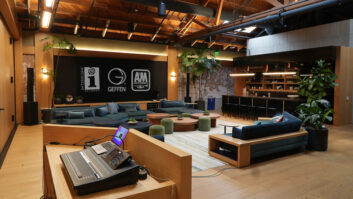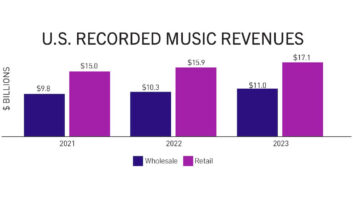Skeptics raised their eyebrows up and down The Great White Way when the Broadway production of the movie Footloose was slated for the boards last fall. Wags asked how the somewhat dated and slight movie could make for a worthwhile night in the theater. And, more importantly, who would want to see it? Were the producers counting on today’s young teens, who weren’t even born when the 1984 film was a surprise smash with their parents?
As expected, Broadway’s Footloose received a critical drubbing, but advance ticket sales were strong. Clearly, there is some appeal to the story of a big-city boy forced to live in a small town where dancing is forbidden and where his every move is a misstep. “The story seems to have an emotional appeal that is beyond any explaining,” said Walter Bobbie, Footloose’s director and co-author, in InTheater magazine. The show’s combination of up-to-the-minute dance moves, a cast of young, energetic, polished singers and dancers, clever staging and snappy tunes makes for a fast, fun evening. On good nights, when the house is full and the excitement generated by the charming, athletic and enthusiastic cast peaks, by all reports the mostly young audience stands up and screams with sheer delight. And it isn’t only happening on Broadway-the producers also have a touring production out on the road.
On a Monday in November, a little more than a week after the show’s opening night, Footloose’s 40 cast members got together in the big room at Hit Factory to take the usual one-day shot at distilling the show’s essence into an audio-only experience: the cast album. With Broadway runs now being overshadowed by touring companies in their impact on the producer’s bottom line, it seemed a good idea to have a cast CD available as soon as the road company’s buses and trucks began to roll.
The tension and excitement of recording the show in one marathon run appeared to be one of the few similarities between the Footloose session and other typical cast recording dates. Unlike a normal Broadway cast session, where the singers face the conductor and the orchestra all together in the biggest studio available, the room appeared devoid of musicians. The show’s leads were all arranged around the piano played by the show’s slightly manic conductor, Doug Kastaros.
Had the tracks been laid down in advance for the singers to overdub? Upon closer examination, the half-dozen or so musicians were found, hidden behind baffles and in iso booths, pop-music style.
“Footloose is a real hybrid, musically,” says Tom Snow, who co-wrote much of the music for the original film, as well as nine new songs for the stage show (with lyricist Dean Pitchford; Snow also co-produced the cast record with Tom Krasker). “The vocals are very Broadway-like with the big chorus and lots of dynamics and step-outs, but backing the singers is an amplified pop band. We started out thinking about the sound of the record as the integration of the ambient sound of the 40 voices in the studio, with a very live stage, with the precisely tracked and mixed sound of a pop band.”
“We’re walking a fine line between pop and theatrical recordings,” adds Trasker. “We don’t have a lot of predecessors to refer to.”
“On a conventional show album done with an orchestra, you give some isolation to the principal singers and then make the orchestra and the chorus be one sound element,” adds engineer Joel Moss, who is not only a veteran of numerous cast album sessions, but also recorded the Footloose film soundtrack album nearly 15 years ago. “In this case, the sound element that’s most exciting in the show is the chorus and the singers. The band is a rock ‘n’ roll band. So we did everything the opposite: We took the band and isolated them and we made the big room at The Hit Factory be a giant vocal booth where we set up a very large spread on this chorus of 40 people, and then we brought the nine principal singers downstage in front of the chorus and created the spatial effect with the voices. I recorded the instruments pretty much as if it was a pop record.
“We broke the chorus into sections because there’s a lot of Bachian interplay in the vocals, where one part is singing a hymn, say, and another more of a background type thing,” Moss continues. “So we had three large setups with risers that were in a big arc around the back of the studio and the principals down front. Each section was miked LCR with TLM170s in omni, so there were nine mics on the chorus. I had TLM 50s in an LCR pattern that were the basic overall frontal mics, and then B&K 4011s behind the chorus as the surround mics. For the soloists, we primarily used TLM170s, which they had a lot of at the studio.
[For economic reasons] we stayed away from some of the more esoteric tube microphones that I would normally rent for the soloists.”
Moss worked on Studio A’s SSL 9000J console, cutting to high-bit multitrack through Avalon preamps. “We recorded everything to 48 tracks at 24-bit,” he notes. “There’s never been a cast album done that way, and probably about five albums ever. The technology is pretty new-we’re using the new Sony 3348 HR recorder, and the signal stays 24-bit all the way through the mixing and mastering, which is being done to the Sony PCM 9000 optical disk. I’ve been locked in digital hell for so many years because of all the orchestral things I do. I’m not a 16-bit fan. I’ve got that thing-not as strong as some of my friends who can’t stand to be in the same room with it-but I heard little digital stuff happening. But 24-bit is beyond that.”
Snow points out that “cast recordings are usually fraught with sheer terror” because of the pressure of having to record the entire album in one day. This is due to strict Broadway Actor’s Equity union rules dictating that each cast member be paid one week of salary for each day of recording; any overtime automatically triggers another full week of pay. So 55 minutes of music and voices had to be recorded in a single 14-hour session.
That said, “These were the smoothest and most satisfying cast sessions I’d ever been through,” says Krasker, whose cast album credits include the Broadway hit Titanic, the recent revival of The Sound of Music, as well as 1995’s I Wish It So by Dawn Upshaw and the current debut album by multiple Tony Award-winner Audra McDonald. “But it just wasn’t that the tracking was smooth; the songs were cut efficiently and also very energetically.”
The session actually was concluded more quickly than some cast tracking dates. It began at 9 a.m. and ended at 11:30 p.m. “There was no overtime whatsoever; the record company was very happy,” Krasker says. Snow adds, “We finished with about eight seconds to spare! When we started that last take, Tommy [Krasker] turned to the contractor and said, ‘Stop us when we’re out of time,’ meaning even if we’re in the middle of the take. Fortunately, we made it all the way through.”
Time is normally set aside in the days following the tracking for cast members to come in and do patches or retrack songs. “You need to schedule that post-session time in case someone gets laryngitis or some other unusual situation comes up,” Krasker explains. For Footloose, two of the leads were brought back the next day to try to inject more intimacy into their big duet, “Almost Paradise,” “without everyone in the studio watching,” Krasker says. “It worked, and those are the takes we used.”
What’s the secret to getting 55 minutes of great recordings out of a single long day from a group of very young professionals? “Part of the reason things went so well is Tommy Krasker’s great vision of how to organize the day,” Snow explains. “You don’t want the entire cast there for 12 to 14 hours, so you stagger the artists’ call times to allow them to be as fresh as possible when they’re needed on mic.”
“Basically, I scheduled the smaller numbers for early in the day so that we could get our own pacing together before we were trying to deal with a room full of 40 voices,” Krasker explains.
The Footloose recording was also a noteworthy and taxing technical undertaking because it was recorded with an eye toward a possible 5.1 release. “We did the main tune and the finale as a sort of calling card for the 5.1,” Moss says. “Most 5.1 audio releases are created after the fact. But for Footloose we set up the chorus and principals in the studio in such a way that we created the appropriate spatial quality with regards to the three dimensions.”
The principals’ mics were set up in a left-right pattern, and “we envisioned the movement onstage when we did that,” Moss notes. “So the principals moved to the appropriate mic station relative to their position on the soundstage rather than having us create that movement through panning, because we were also taking ambient sound from overhead mics. So as they moved from one of the principal mics to another, they also moved within the ambient space.” The chorus was treated in a similar way.
For the mix, Moss worked on The Hit Factory’s Sony OXF-R3 (Oxford) digital console, and he gives the new board high marks. “We were able to move through the mixes very rapidly and compare one to the other because of the Oxford’s instant recall,” Moss explains. “Plus, when we got a drum sound we really liked, we could go from song to song and match that sound easily. The Oxford is a great tool. If you’re going to be in the digital domain and have the liberty to use the Sony 3348 HR recorder with its high bit rate, it is really fantastic to be able to maintain the digital purity all the way to the final mix. There was absolutely no coloration of the sound that we didn’t create ourselves.”
Moss says he enhanced the sound in the mix by adding a bit of reverb, but most of what’s on the CD is the sound of the room. “I used the B&Ks [intended for the 5.1 recording] in the stereo mix, too-I added them as a reverb element, and it was actually quite nice. There was a little time delay that happened with those mics, and that kept us from having to go too deep with the outboard stuff.”
With the tracks in the can, the team faced a grueling post schedule. “We’re trying to make a two-week turnaround from tracking to master,” explains Krasker. “It’s a fairly intensive schedule for us, but the CD is a pretty important piece of paraphernalia to the touring shows, so we’re hard at work, ten-plus hours a day.”
The hard work was worth it. The producers and Moss have effectively transformed the theatrical experience to the CD. While the recording cannot re-create the spectacle of several dozen enthusiastic young people dancing and singing their hearts out, the power of the vocal performances and the essential energy of the endeavor come through. “We wanted to capture the youthful power of the show,” says Krasker. “We’re quite pleased to say that we believe we succeeded.”

